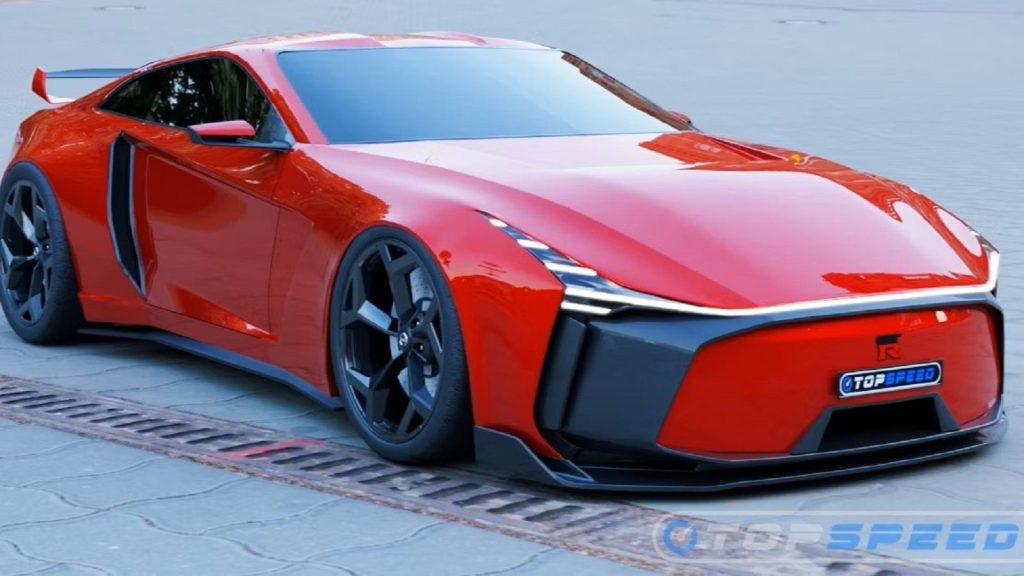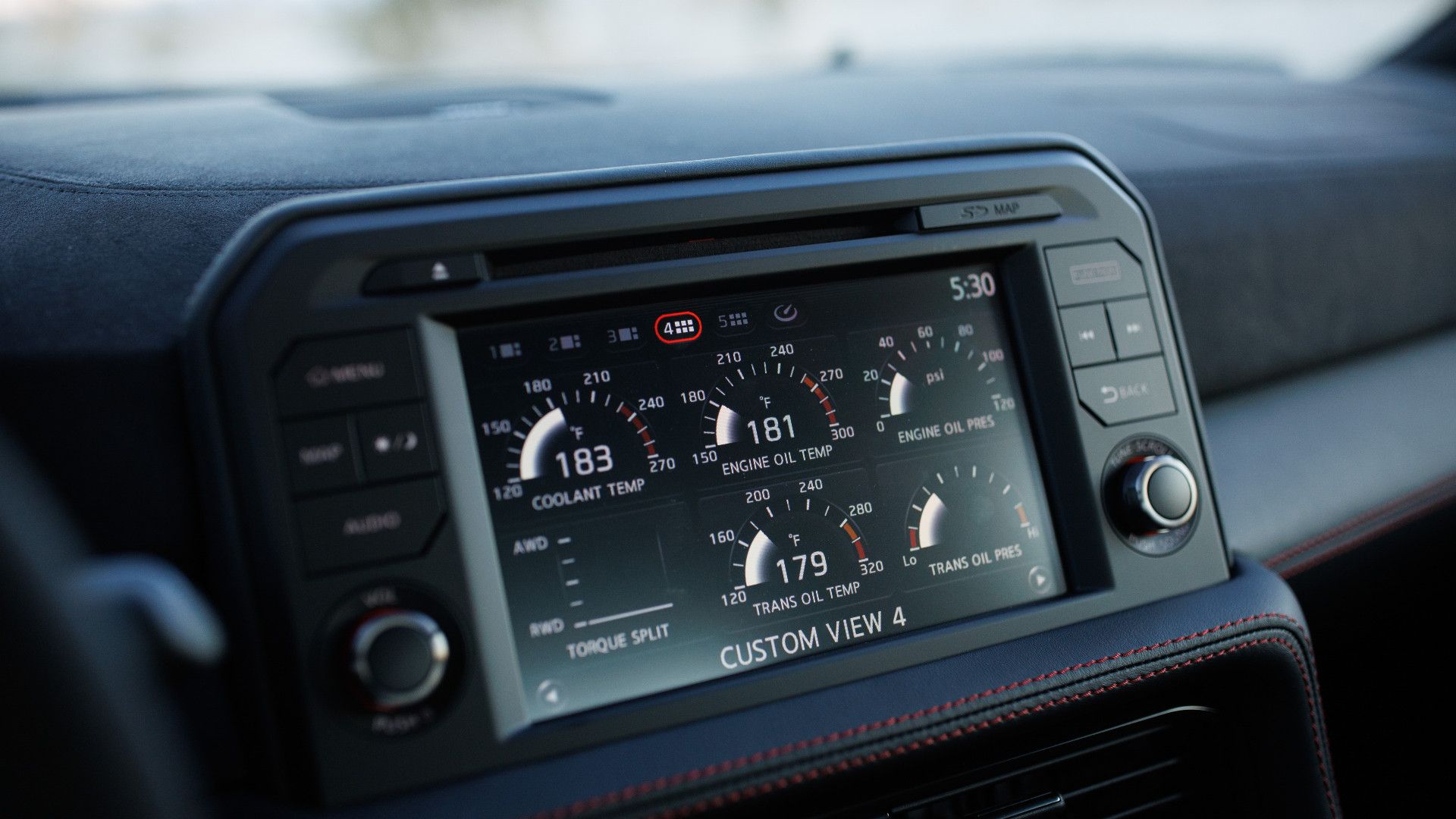Summary
- The Nissan GT-R’s potential transformation into an electric variant requires a powerful electric powertrain and advanced battery technology to maintain its speed and agility while prioritizing affordability and luxury.
- Strategic interior design strategies like a “frunk” and a sliding center console can maximize cargo and interior space in the electric GT-R, offering increased storage capacity and adaptability for occupants.
- To compete with high-performance electric vehicles, the Nissan GT-R EV must match or surpass their acceleration capabilities while incorporating advanced driver-assistance features and offering fast charging capabilities to align with industry standards. Nissan’s commitment to innovation and excellence is crucial in preserving the GT-R’s legacy.
The Nissan GT-R celebrated for its remarkable performance, accessible price point, and iconic reputation, has garnered a substantial fan base. Its lineage traces back to the Nissan Skyline GT-R models, showcasing a rich history in both racing and street culture. With a robust V-6 engine, all-wheel drive, four-seat capacity, programmable multi-function display, and more, the GT-R boasts a range of enticing features. As the automotive landscape shifts towards electrification, the GT-R stands at the cusp of a potential transformation into an electric variant.
This evolution mandates careful considerations: to maintain its speed, a potent electric powertrain, high torque, and advanced battery tech are vital. Agility must persist via meticulous engineering focused on a low center of gravity, a harmonized chassis, and responsive steering. Upholding its luxury status necessitates a polished interior, premium materials, and cutting-edge features, all while prioritizing affordability through innovative production methods and cost-effective components. Nissan’s triumph in this endeavor hinges on realizing these imperatives, thus ensuring the GT-R’s legacy endures while charting the course for the next phase of this automotive icon’s evolution.
1 Not A Whole Lot More Expensive Than The ICE GT-R
The pricing configuration of the Nissan GT-R is intricately tied to the specific trim level chosen, coupled with optional features. Notably, as cited by Nissan, the entry-level Premium trim for the 2023 model year commences at a base Manufacturer’s Suggested Retail Price (MSRP) of $120,990. Beyond this initial tier, the pricing spectrum expands as one ascends to the more premium Track Edition and NISMO trims, the latter commanding a significantly higher price point of up to $220,990.
In the contemplation of a potential paradigm shift towards a fully electric rendition of the illustrious GT-R, the necessity of aligning the pricing of the electric variant with the existing GT-R MSRP assumes paramount importance. This endeavor embodies a delicate equilibrium, encapsulating the formidable task of maintaining cost equivalency during the transition to electric propulsion, thereby preserving the model’s accessibility and prestigious standing within its well-defined market segment.
2 An Expansive Cargo And Interior Cabin Space
Nissan can strategically amplify the interior expanse within the electric GT-R through an array of inventive strategies. A notable approach involves the assimilation of a “frunk,” denoting a front trunk that maximizes the unoccupied compartment resulting from the absence of a conventional engine. The frunk serves a dual purpose by augmenting storage capacity for belongings, equipment, and miscellaneous items, while also contributing to the optimization of both the vehicle’s weight distribution and its aerodynamic characteristics.
Nissan GT-R Interior Dimension Specs
|
Front Headroom |
38.1 Inches |
|
Front Legroom |
44.6 Inches |
|
Rear Headroom |
33.5 Inches |
|
Rear Legroom |
26.4 Inches |
|
Cargo Capacity |
8.8 cubic-feet |
Furthermore, an additional avenue for optimizing spatial allocation revolves around the incorporation of a “sliding center console.” This versatile console can be seamlessly adjusted, affording an expansion of legroom or armrest space for occupants, including both passengers and the driver, thereby cultivating heightened interior adaptability and personalization.
3 A Power Boost You Can Feel
Enhancing the 2024 Nissan GT-R’s performance involves a mix of aftermarket modifications and innovative technologies. Performance chip tuning helps optimize the electric motor controller’s software, potentially unlocking greater horsepower and torque. Complementing this, a cold air intake system could improve airflow for enhanced performance. If Nissan were to offer a GT-R in an electric variant, it would probably need a large and powerful battery pack to maintain its performance and range.
Specs and Features
|
Engine |
3.8-liter DOHC 24-valve twin-turbocharged V6 |
|
Power Output |
565 horsepower |
|
Torque |
467 pound-feet |
|
Drivetrain |
AWD |
|
Transmission |
Dual-clutch transmission |
In comparison, the Tesla Model S Plaid has a 100 kWh battery pack that can deliver 1,020 horsepower and 390 miles of range. Upgrading to a high-voltage battery would offer a substantial power boost. These modifications combine to maximize the potential of the electric powertrain, elevating the GT-R’s performance prowess. This confluence of measures aims to harness advancements in electric motor technology and maximize the output of the GT-R’s electric powertrain, offering a noteworthy increase in horsepower and torque beyond the existing twin-turbo V-6 engine, automatic transmission, and all-wheel drive configuration, thereby charting a path towards a more potent and electrifying driving experience.
4 Acceleration Capabilities Rivaling The Top Electric Sports Cars
The Nissan GT-R has a long and proud history of being one of the most thrilling and powerful sports cars in the world. However, with the advent of high-performance electric vehicles, such as the Porsche Taycan, the GT-R faces a new challenge to keep up with the evolving standards of performance and innovation.
Specs and Comparison
|
0 to 60 MPH |
|
|
Porsche Taycan Turbo S |
2.6 seconds |
|
2024 Nissan GT-R Nismo |
2.9 seconds |
|
Tesla Model 3 Performance |
3.1 seconds |
The Porsche Taycan is a potential competitor for the Nissan GT-R EV, as it offers a range of impressive specs, such as over 402 horsepower, and the ability to accelerate from 0 to 60 mph in 5.1 seconds in its base trim. The top-of-the-line Taycan Turbo S, for example, can accelerate from 0-60 mph in an impressive 2.6 seconds with an amazing power output of 750 horsepower, making it one of the fastest electric cars on the market.
To maintain its legacy, the Nissan GT-R EV must strive to match or surpass these benchmarks and offer something unique and distinctive to its loyal fans and new customers alike. Under any pretense, the Nissan GT-R EV must at least match the acceleration capabilities of its gas version to prove that it can still deliver exhilarating driving experiences in the era of electrification.
5 Offer Plenty Of ADAS Features
The GT-R EV must balance thrill and safety, a key aspect of any sports car. The gas-powered GT-R has basic safety features, such as airbags, traction control, and parking sensors. However, electric sports cars have advanced features that boost security and convenience, such as adaptive cruise control, blind-spot monitoring, forward collision warning, lane-keeping assist, and a 360-degree camera. These features enhance driver confidence and prevent accidents by monitoring and intervening in critical situations.
The Nissan GT-R EV should adopt these features, inspired by electric sports cars like the Tesla Model S and the Porsche Taycan. This would elevate the driving experience to new levels of safety and performance, reflecting the electric vehicle industry’s innovation and excellence. The electric Nissan GT-R’s safety evolution would ensure that its electrifying potential is matched by a reliable shield of protection.
6 Charge As Fast As It Runs
The charging speed of sports electric vehicles in the USA varies based on charging station type, battery capacity, and vehicle charging curve. On average, Level 1 (120 volts) stations take hours to add 100 miles of range, while Level 2 (240 volts) stations take around an hour for the same range increase. DC fast chargers (480 volts or higher) achieve an 80-percent charge in 20 to 40 minutes.
Notably, swift-charging sports EVs include the Porsche Taycan, which can gain 60 miles of range in 4 minutes and achieve 80 percent of range in 15 minutes at a 225 kW DC fast charger. The Tesla Model S reaches a similar range in 15 minutes at up to 250 kW at a Supercharger, while the Lucid Air achieves a range of 200 miles in 12 minutes at 350 kW. In the context of maintaining the GT-R legacy, Nissan must offer improved value and charging capabilities to align with these standards, ensuring a compelling proposition for their electric offerings.
7 Be As Mechanically Sound As The Fuel-powered GT-R
Setting the 2024 Nissan GT-R apart are its exclusive features that define its exceptional performance and driving experience. The ATTESA E-TS All-Wheel Drive dynamically allocates torque between the front and rear wheels, optimizing traction across diverse road conditions. The Bilstein DampTronic suspension adeptly adjusts damping force per shock absorber, aligning with road surfaces and driving modes for heightened handling and comfort. A multi-function display provides insights into performance metrics like boost pressure, and acceleration displayed on the center console.
The Nissan/Brembo braking system boasts powerful six-piston front and four-piston rear calipers, cross-drilled rotors, and brake cooling guides, delivering precision in braking. As the 2024 Nissan GT-R holds massive potential to be converted into an electric iteration, preserving these distinctive attributes becomes paramount to continuing the legacy and delighting fervent fans thus, ensuring that the iconic Nissan GT-R’s essence is seamlessly transposed to its electric counterpart.
8 A Speaker System The Mimic The Powerful Sound Of The OG GT-R
Nissan could add a speaker system to the electric GT-R that emits the same sound as the original gas-powered GT-R. This would help to address one of the biggest concerns that many people have about electric cars- the lack of engine noise. There are a few different ways that Nissan could implement this system. In the U.S., some EVs use speakers to create engine-like sounds, serving driving experience enhancement, regulatory compliance, and pedestrian awareness. Techniques include Glydsphere, enabling adjustable engine sounds via an app and front-mounted speaker.
Borla’s system matches vehicle speed with exhaust-like tones via a controller. Notably, Porsche’s Taycan features a 14-speaker Burmester audio setup, enhanced by Electric Sport Sound, adding emotive tones to the electric drive’s sound. These systems would be able to produce a variety of sounds, including the sound of the engine, the sound of the exhaust, and even the sound of the tires on the road.
9 Tech That Keeps The Nissan GT-R EV One With The Times
In the 2024 Nissan GTR, you’ll find an eight-inch central touchscreen as part of the NissanConnect system, offering Apple CarPlay, Android Auto, SiriusXM Traffic, and an 11-speaker Bose audio setup. A physical rotary knob and hard buttons offer control options. The Nissan GTR also features a digital instrument cluster showcasing data like speed, rpm, gear, drive mode, fuel, engine stats, and tire pressure, with customization options for the driver. The infotainment system can be controlled by a physical rotary knob and a couple of hard buttons. In response to contemporary driving preferences, the forthcoming electric GT-R must seamlessly incorporate these cutting-edge connectivity attributes, advanced infotainment systems, and driver-assistance technologies.
By integrating sophisticated driver-assistance systems, seamless smartphone connectivity, and AI-powered enhancements, the driving experience is poised to transcend boundaries. This deliberate fusion of technology not only aligns the electric Nissan GT-R with the modern expectations of discerning enthusiasts but also underscores the brand’s commitment to harmoniously melding performance excellence with state-of-the-art advancements.
10 OTA Updates To Keep It Up-to-date
Harnessing the power of over-the-air updates, the potential electric Nissan GT-R holds the promise of continuous evolution. In an era defined by rapid technological advancements, electric vehicles stand as prime candidates for dynamic software enhancements and feature introductions.
By adopting over-the-air updates, Nissan empowers GT-R owners with effortless access to the latest software innovations and functionalities, obviating the need for time-consuming visits to dealerships. This strategic integration not only streamlines the process of keeping the electric GT-R at the forefront of innovation but also reinforces Nissan’s commitment to elevating user experience through convenience and agility.










